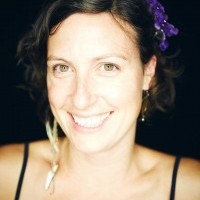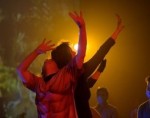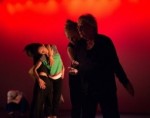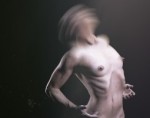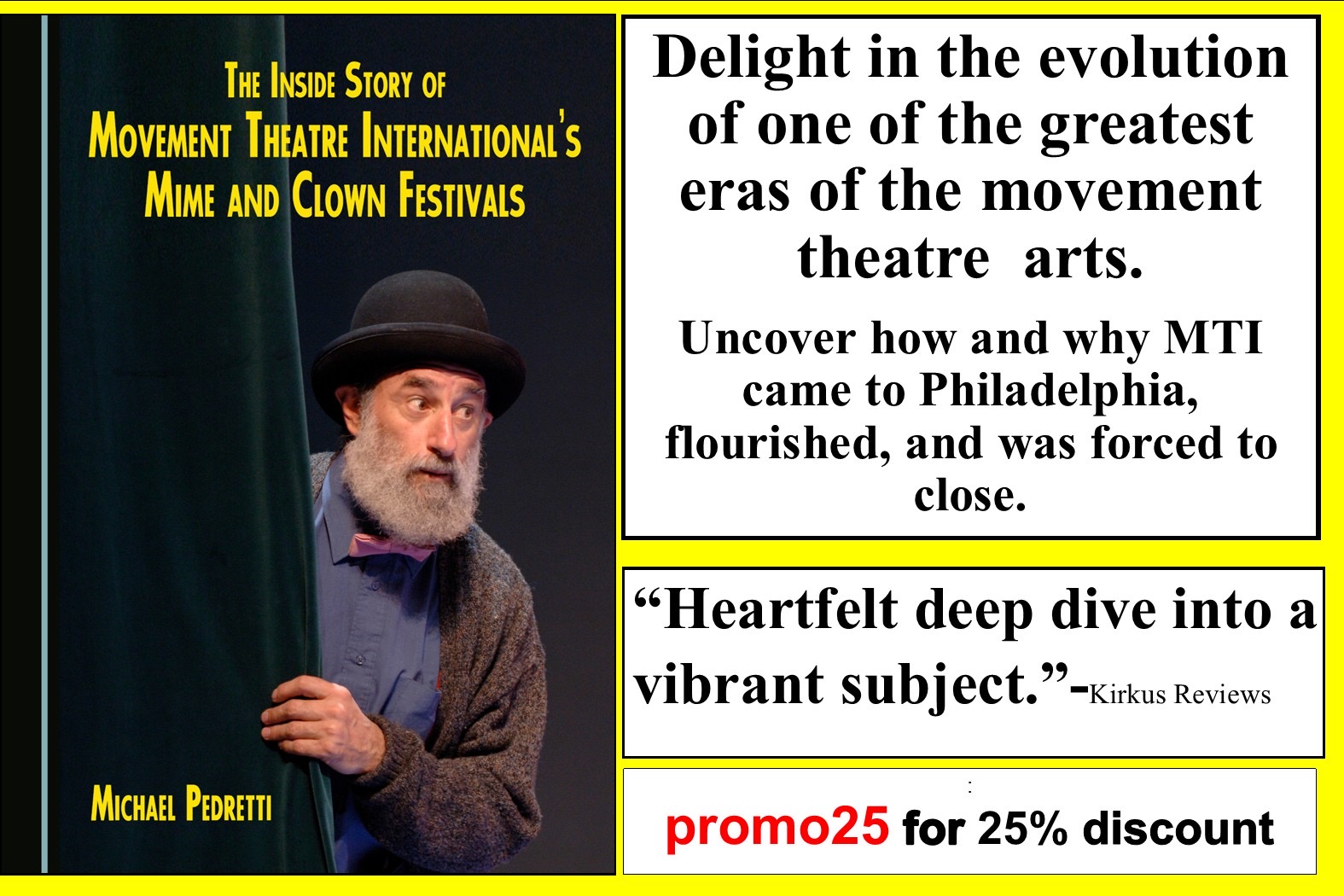
Photo: Lois Greenfield
Which Way Shall I Take to Leave?
by Megan Bridge
Everybody tells me the voices I hear are not there,
the pictures I see are not there.
I don’t care. They’re there for me. That’s what counts.
Sometimes I think my heart will break…
-Robert Ashley, Dust, 1998
Robert Ashley (1930-2014) was not just a composer, but a brilliant writer and librettist whose work in contemporary music, and specifically new forms of opera, sparked the imagination of a range of choreographers, among them Trisha Brown, Steve Paxton and me.
I have been listening to Ashley’s music for about fifteen years, and my appreciation of one of his operas, Dust, has grown into almost an obsession. It opens with Ashley’s solo voice, weaving a fictional story about the characters, homeless people, that the composer can see in a park across the street, looking through the window of his Tribeca apartment.1 He takes on the persona of one of the homeless people, and then introduces the rest, his five friends who also live in the park. One of his friends lost his legs “in some war,” and, after the introduction, the rest of the opera revolves around the story of this character, “No Legs.” The sound of Ashley’s voice in this opening section is what draws me in most powerfully. I hear wisdom, mischief, sadness, humor. Openness. Breath. His voice sometimes rolls, sometimes bounces, slurs, sings. But it’s mostly talking.
A flashback to the moment in which No Legs actually loses his legs and receives repeated morphine shots to numb the pain becomes a kind of hinge point for the entire opera. On morphine, No Legs has a conversation with God, where all sorts of tripped out and philosophical insights are revealed in a jumbled and repetitive way. Ashley’s voice is joined by a chorus of four other singers (Sam Ashley, Thomas Buckner, Jacqueline Humbert and Joan La Barbara) using a musical technique called
hocketing. Over the course of the first act, each “friend” in the park, played by a member of the chorus, sings (or, rather speaks in a melodic and rhythmic cadence) one of No Legs’s stories of his years before the war. During each story, an undercurrent of voices chants fragments of the conversation with God. The soloist’s layer is a dense and detailed narrative, sometimes mundane, sometimes insightful, but the subtext is a dark, non-linear description of fields of bodies in the war-torn landscape and what is going through No Legs’ mind when he receives the morphine. Ashley is adept at describing the affective tone of a moment in time:
Then there are the memories. I don’t know what else to call them.
From the time before the legs thing.
From the time before the bullets were flying all around,
and all the noise and screaming, and he
looked down and there is nothing there…
-Robert Ashley, Dust, 1998
The voices and the unfolding narrative are supported by an electronic score that is sonorous, vibrant, sometimes percussive. The rhythmic structure is precise (four of the sections are exactly the same length, nine minutes and fifty-seven seconds, and are made up of 224 four-beat lines).2 One can step into this music, entering different architectural chambers of sound with each shift of key, or of character.
I got up the nerve to e-mail Ashley in late 2012 to request permission to choreograph
Dust. Ashley gave me the go-ahead, and I started with a
solo study, for which I developed the movement material and structure through repeated daily improvisations (I was just coming out of a
workshop with Deborah Hay). Rather than sitting down and making decisions about what I wanted to do, I put the music on and danced to it, every day for a month. As I practiced, material began to arise, and then to stick: shaking, vibrating, lolling, boxing, jumping up and down. In creating the movement, I tried to work equally in response to the cadence and melodies of Ashley’s voice, the rhythmic structures in the music, and the unfolding narrative. After sharing video via email with Ashley (or Bob, as most everyone calls him, and we were now on a first-name basis in cyberspace), he granted me permission to continue with the project and work with the 1998 recording of
Dust to choreograph the full ninety-minute opera. Around that time (June, 2013), Ashley received a diagnosis of liver disease. I never heard from him again, and never had the chance to meet him.
Ashley died last month, just five weeks before the premiere of his new opera,
Crash, which
opens this week at the Whitney Biennale. Also this week as part of their
season at New York Live Arts the Trisha Brown Dance Company is remounting
Son of Gone Fishin’, a work with music by Ashley.
I spoke with Diane Madden, now Trisha Brown Dance Company’s Associate Artistic Director, who performed in the work’s premiere in 1981 at Brooklyn Academy of Music and who is directing the restaging. Madden spoke at length about working on Son of Gone Fishin’, a complex, intricately detailed twenty-three minute piece of choreography that’s full of reversals (“How do you uncrumble?”3) and repetition. The choreography hangs on a smart structural framework; Brown worked in silence and the music came later.
Madden’s description of the choreography and the process of its making was detailed: “There were things about the process Trisha used to make Son of Gone Fishin' that were consistent with [Brown’s works] Opal Loop before it and Set and Reset after. It was basically, you make a phrase of material, teach it to dancers so they have a movement vocabulary, give them instructions to improvise with it, then very tediously set the improvisation, memorized down to the smallest detail. It’s very set choreography. She has some complex forms, she can be very mathematical. The structures within her choreographies are very solid, you can stand on them, you can dance on them.
“But Son of Gone Fishin’ is just way over the top, there are other layers of complexity involved that are not present in any of Trisha’s other dances. She started by making a beautiful phrase of material, it’s like Trisha Brown technique 101 in a way, all about crumbling, verticality and re-stacking, sequencing through the body. She taught us the phrase, asked us to flip it to the other side, then reverse both sides. All of a sudden you’ve got a lot of movement possibilities from one phrase, and it’s very, very specific, very precise. She put three dancers upstage, three dancers downstage, and asked us to improvise our way through the phrases, making choices in all four directions, passing through each other. So we made a five-minute long, six-person ensemble, constant motion, no exits, this complex, constantly moving structure. It’s gorgeous, we know what we’re doing. And then she says, reverse that. All the convergences, all the interactions, all the partnering. There’s not a lot of weight-dependent partnering but there’s a lot of really close interaction. All of that we had to figure out how to do in the opposite direction. That’s the main fabric of the piece.”
This complicated structure is repeated a second time almost exactly like the first, with a center section insert that works with canon or “feathering,” Brown’s word for an unmetered canon. Madden talked about how layered and dense the choreography is, and how this was complemented by the layers and density of Ashley’s music that was playing alongside, underneath, and around the dance.
“The music is absolutely fantastic,” Madden said, “it just transports you.” Performing Son of Gone Fishin’ was a transformative experience for Madden, and she’s trying to recreate that journey with the current company. At first the complexity of the choreography was daunting. “I didn’t know how to perform it, and it was agonizing for me, for a long time, until I finally just let go. It was this huge step in my evolution as a performer to learn how to be in the moment ... to stay present and joyful about it.” Madden felt supported by Ashley’s music (and by his presence in the orchestra pit at BAM for the work’s premiere). It let her take a step into a different realm as a performer, partially because the music “is so trippy! It just asks you to go for it, to just go with it.”
While recordings of The Grateful Dead and Bob Dylan had been used in earlier works, Son of Gone Fishin’ was Brown’s first true collaboration with a composer. The score Ashley created came from the orchestral parts of three operas in Ashley’s Atalanta (Acts of God). He mixed three taped versions of three different pieces (titled “Willard,” “Max,” and “Bud”), and though Ashley performed live at Son of Gone Fishin’s premiere at BAM, the company used the tapes when they toured the work. The dancers had the freedom to choose which taped version of each song to use for each performance. In the music, according to Madden, “very much like Trisha’s work, there is a through-line, a connectedness between sections. Even though the songs can feel very different from each other, the structure underneath is consistent. Some of the songs have a very driving rhythm, even a beat. Towards the middle things get really challenging, there’s more discord in the music, chaos, abrasive sounds … like spaceships landing, and someone hitting the keys on a piano really hard repeatedly. It can get really thick and hard to wrap your ears around. You have to go through it somehow, get through it. Then it veers towards being very romantic or sentimental, playful, there are chords, melody, synthesizer sounds … almost, dare I say it, cheesy.”
When conversations began around the restaging of Son of Gone Fishin,’ Ashley was unable to provide the company with his original tapes, so audio engineers were called in to restore reel-to-reel and cassette tapes that the company had used in the work’s original touring. Madden planned to get together with Ashley to talk to him about the work, which so impacted her performance experience as a twenty-one-year-old, brand new to Brown’s company. “I was thinking I would love to set up an oral history. Then I got word that he wasn’t well.” Madden missed her chance to remake that personal connection with Ashley, whom she secretly called “Uncle Bob. He was just such a sweetheart. I just loved him .... He had this really gentle and funny dry humor, and was obviously super creative and smart, but also just a regular guy.”
Steve Paxton, too, has worked on significant projects with Ashley’s music over the last four decades. According to an e-mail exchange I had recently with Paxton, “The
Once Group invited the Judson Dance Theater to perform in Ann Arbor. I met Bob there (circa 1963). Further invitations ensued in both directions.”
4 Perhaps Ashley’s best-known work,
Perfect Lives, is an opera for television in seven parts (or episodes), commissioned by The Kitchen and first broadcast in Great Britain in 1984; an opera about which
John Cage said “What about the Bible? And the Koran? It doesn’t matter. We have
Perfect Lives.” Part I,
The Park, and Part VII,
The Backyard, were released in the mid-1970s as
Private Parts. Paxton and
Lisa Nelson created a duet called PA RT using this music and continued to perform it for thirty years. Lisa Kraus, another former Trisha Brown Dance Company member (and editor-in-chief of thINKingDANCE) holds up Paxton and Nelson's dance as “the most amazing kind of character-filled visualization of an Ashley piece I could imagine.” Paxton described his process of choreographing PA RT: “I listened to the drone of [Ashley’s] voice until I knew both the strange wonderful story he was telling and the cadence of his voice. I used improvisation, two characters; the structure for the hour performance was solo, duet, solo, duet.”
Paxton also performed in a series of films (the “Dr. Chicago” series) by George Manupelli in the early seventies, with sound by Ashley, and in 2001 Paxton and Nelson created another duet using Ashley’s music. In the years leading up to his death, Ashley was working on a new opera called QUICKSAND. In an e-mail correspondence I had with Ashley in the summer of 2013, he referred to QUICKSAND as a “dance opera,” with choreography by Paxton, and he told me it would likely premiere at The Kitchen in January 2015. The status of the project, and whether it will move forward despite the composer’s passing, is unclear at this point.
After being bowled over at first by the density of text and narrative in Ashley’s work, now I encounter it as a sort of magical world that I can step into and move through, hearing new things every time. The work cultivates a practice of deep listening and fully embodied presence for me. A trip, as Madden said. And in Paxton’s words, “The text is very dense, and I reckon that in a single hearing the audience will only be able to absorb fragments. But, what fragments!”
She makes a double life.
She makes two from one and one.
She makes a perfect system every day.
She makes it work.
She stands there in the doorway of her mother’s house
looking at the grass and sky and at where they meet,
never once thinking thoughts like
it’s so like a line,
or, the difference is so powerful,
or, which way shall I take to leave.
-Robert Ashley, Perfect Lives, 1983
Notes:
1. Robert Ashley, by Kyle Gann. University of Illinois Press, 2012, p. 116
2. Ibid., p. 118
3. All quotes from Diane Madden are from a phone interview conducted by Megan Bridge on April 2, 2014.
4. All quotes from Steve Paxton are from an e-mail exchange between Bridge and Paxton in early April 2014.
Trisha Brown Dance Company, New York Live Arts, April 8-13, 2014. The run is sold out,
check here for wait list information. The Thursday, April 10 performance will be live streamed at
2ndline.tv/trisha_brown at 7:30pm.
Whitney Biennial presents Robert Ashley and Alex Waterman, performances of three different Ashley operas directed by Waterman.
Crash April 10-13,
Vidas Perfectas (the Spanish version of
Perfect Lives) April 17-20, and
The Trial of Annie Opie Wehrer and Unknown Accomplices for Crimes Against Humanity, April 23-27.
Tickets and information here.
Read Steve Paxton's Letter to the Editor in response to this article
here.
By Megan Bridge
April 8, 2014


